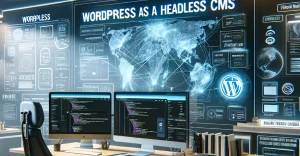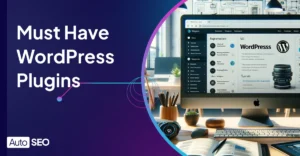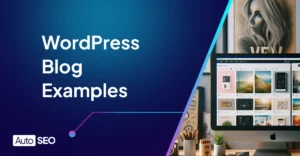WordPress as a Headless CMS

WordPress is well-known for creating traditional websites. Lately, it has also become a strong tool for making headless CMS platforms. But what does that mean?
In this article, we’ll explain the concept of WordPress as a headless CMS and why it’s a game-changer for developers and website owners. Whether you’re experienced with WordPress or new to CMS, understanding headless WordPress is a crucial step in keeping up in the digital world.
Table of Contents
Understanding WordPress as a Content Management System
Conventional CMS vs. Headless CMS
When comparing conventional CMS and headless CMS, it’s important to consider the key differences between the two.
Conventional CMS, such as WordPress, are known for their all-in-one approach. They provide a user-friendly interface and a wide range of built-in features for website development and management.
On the other hand, headless CMS, like headless WordPress, separate the content management and presentation layers. This allows for more flexibility and scalability in delivering content across various platforms and devices.
The evolution from WordPress to headless WordPress has a significant impact on website development and management. With headless WordPress, developers have the freedom to utilize modern technologies and frameworks to create interactive, dynamic, and personalized user experiences. However, this also requires more technical expertise and the need to build the presentation layer from scratch, which can be a drawback for some users.
In terms of benefits and drawbacks, using a headless CMS offers the advantage of easier content distribution and better performance, especially for complex websites or applications. However, it also comes with the challenge of increased development complexity and potentially higher costs for implementation and maintenance.
Evolution from WordPress to Headless WordPress
Traditional WordPress and Headless WordPress offer various benefits:
- Improved performance, flexibility, and better scalability.
- The decoupled architecture allows for separate frontend and backend developments.
- Faster loading times and a smoother user experience.
- Different hosting requirements and configurations compared to traditional WordPress.
Key features and functionalities of Headless WordPress:
- Ability to integrate seamlessly with various frontend frameworks.
- Flexibility to develop custom content structures.
- Capacity to deliver content across multiple platforms.
These capabilities make Headless WordPress a powerful and adaptable option for modern content management needs.
The Rise of Headless CMS Platforms
Benefits of Using a Headless CMS
Using a headless CMS has many benefits. Content is not tied to one presentation layer, making it more flexible and scalable. This allows content to be easily repurposed and delivered across different platforms and devices, providing a seamless user experience.
A headless CMS also helps content editors work more efficiently, focusing solely on content creation and management without worrying about traditional CMS limitations.
For consumers, this means faster load times and better performance, leading to an improved user experience. Decoupling the front-end presentation from the content management system empowers organizations to adapt to changing technologies and consumer behaviors in a more agile and cost-effective way.
Drawbacks of Headless CMS Solutions
Headless CMS solutions have limitations and challenges. They can make it difficult to manage and customize content compared to traditional CMS platforms. The separation of content management and presentation layers in a headless CMS can make it harder to preview or visualize how content will be displayed on the website. This can lead to potential inconsistencies or difficulties for content editors and developers.
Integrating with third-party plugins and tools may also be impacted by the headless approach. The decoupling of the front-end and back-end systems can create compatibility issues and limitations. This can hinder the flexibility and functionality of the website, making it harder to implement certain features or functionalities that are readily available in a traditional CMS.
While headless CMS solutions offer advantages in flexibility and the ability to use modern technologies, there are also drawbacks to consider when choosing a platform for managing a blog or website.
WordPress as a Headless CMS Blog: Core Features
The WordPress REST API
The WordPress REST API allows developers to access and interact with WordPress data in a headless CMS setup. It uses HTTP requests for seamless communication between the WordPress backend and frontend. This enables the creation, retrieval, update, and deletion of content.
Using the API plays a significant role in ensuring the performance and efficiency of a headless WordPress website. By separating the frontend to a different application, the backend can focus on managing content. This results in faster load times and improved user experience.
When integrating custom post types with the WordPress REST API in a headless CMS architecture, developers must carefully structure and retrieve the data. They need to configure API endpoints to handle custom post type requests and format the data for optimal display on the frontend. Additionally, they should consider authentication and authorization mechanisms to secure the API endpoints.
Custom Post Types and Their Role in a Headless Setup
Custom post types are important in a headless setup using WordPress for a blog. These types allow for specific data structures tailored to the content, like products, portfolio items, or events. This offers flexibility in organizing and displaying information. Defining custom post types enhances the CMS functionality, enabling better support for different content types beyond standard blog posts and pages. This contributes to a more efficient and structured content management process.
For example, an e-commerce site may use custom post types for products with unique fields and attributes, while a news website may utilize them for articles, videos, and interviews, each with specific data and formatting requirements.
Technical Aspects of Setting Up Headless WordPress
WordPress Hosting Considerations
Running WordPress as a headless CMS for a blog has specific hosting requirements to think about. The hosting environment affects how well a headless WordPress setup performs and how easily it can grow.
When choosing a hosting provider for a headless WordPress CMS, it’s important to consider factors like:
- Server response times
- CDN (Content Delivery Network) integration
- Server-side caching
- Support for modern web technologies like GraphQL and REST APIs
Make sure the hosting provider can also handle application-level caching and scale resources based on traffic fluctuations. These requirements are important for a reliable and high-performing headless WordPress blog setup.
WordPress as a Headless CMS Blog: Building the Frontend
WordPress as a Headless CMS Blog has important considerations for building the frontend. Developers need to think about content structure, data handling, and performance optimization.
When handling post data, developers can improve performance in a headless WordPress setup by using the REST API to fetch and display content. They can also implement caching strategies to reduce load times.
Plugins are also crucial in a headless WordPress setup, providing additional functionality for the frontend. They can streamline development, enhance user experience, and improve website performance. For example, developers can use plugins for SEO, image optimization, and caching to make sure the frontend runs efficiently.
Post Data Handling and Performance
Handling data in a headless WordPress setup can impact performance. When dealing with lots of data like posts, images, and media files, the system’s efficiency may decrease, causing slower load times. To optimize performance, it’s important to use caching, optimize database queries, and leverage content delivery networks. These practices help to speed up load times and enhance user experiences, contributing to the success of the WordPress blog as a headless CMS.
Plugins in a Headless WordPress Setup
When setting up plugins for a headless WordPress site, it’s important to choose lightweight and minimalist options. These plugins should work well with the limited functionality of a headless setup and not rely heavily on server-side processes.
Integrating plugins in a headless WordPress architecture can improve user experience by adding e-commerce, SEO, or social media features. To ensure smooth integration with the frontend, it’s best to research and test the plugins’ compatibility with the chosen frontend framework.
Consider factors like API support and performance impact. Configuring the plugins in a way that maintains speed and security while meeting the blog’s specific needs is crucial.
Real-World Applications of WordPress as a Headless CMS
The shift from traditional WordPress to headless WordPress has made a big impact in real-world applications. By separating the front-end presentation from the back-end content management, developers can now create more flexible and customizable digital experiences. This is especially helpful for e-commerce, news media, and online publishing, where seamless content delivery is crucial.
Businesses and organizations have used headless WordPress to innovate and create dynamic digital experiences for their audiences. For instance, e-commerce companies use it for product catalogs and custom shopping experiences, while news media outlets use it for personalized content delivery.
Steps to Set Up WordPress as a Headless CMS
Setting up WordPress as a Headless CMS involves considering a few technical aspects. For example, ensuring proper APIs, incorporating a front-end framework, and using webhooks for real-time updates.
Custom post types can be used in a Headless WordPress setup. This involves defining and structuring content to fit specific needs, providing flexibility and scalability in the content management system.
Selecting the right tools and services for Headless WordPress includes steps like evaluating features and integrations offered by different platforms, considering scalability and performance, and analyzing cost and support options.
By carefully considering these technical aspects and steps, WordPress can effectively function as a Headless CMS, providing the flexibility and customization needed for modern content management systems.
Selecting the Right Tools and Services for Headless WordPress
When choosing tools and services for a Headless WordPress setup, it’s important to consider scalability, performance, and compatibility with WordPress APIs. The specific needs and goals of a project can guide the selection process by assessing how well a tool or service aligns with the project’s objectives and required functionalities.
Additionally, it’s crucial to evaluate the ease of integration, documentation support, and ongoing maintenance when integrating third-party services with a Headless WordPress architecture. This helps ensure a smooth integration process and maintains the overall performance of the Headless WordPress setup.
Final thoughts
WordPress can be used as a headless CMS. This means the back-end content management is separate from the front-end presentation. It offers flexibility in using custom front-end frameworks and tools. Headless WordPress is great for dynamic, interactive websites and easier integration with other systems and technologies.
FAQ
What is a headless CMS?
A headless CMS is a content management system that allows for content creation and management, but does not have a front-end interface. It provides content via APIs for display on any platform or device. Examples include Contentful, Prismic, and Strapi.
How does WordPress function as a headless CMS?
WordPress functions as a headless CMS by serving as the backend content management system, while a separate frontend framework, like React or Vue, handles the display and user interface. The WordPress REST API allows for content to be retrieved and displayed on the frontend.
What are the benefits of using WordPress as a headless CMS?
By using WordPress as a headless CMS, developers can leverage its powerful backend while creating a completely custom frontend experience using modern technologies like React or Vue. This allows for better performance, easier content management, and enhanced security.
What are the potential challenges of using WordPress as a headless CMS?
Potential challenges of using WordPress as a headless CMS include increased complexity for non-technical users, potential for plugin compatibility issues, and the need for third-party services for full functionality, such as an API plugin for content delivery.
What are some popular plugins or tools for implementing WordPress as a headless CMS?
Some popular plugins or tools for implementing WordPress as a headless CMS are WPGraphQL, ACF to REST API, and WP REST API.

Written by Peter Selmeczy
As the Head of Growth at AutoSEO I love everything about content, SEO, and AI. Hope you like my musings and would love to talk to you in the comments.



